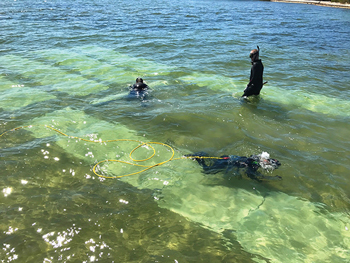Sarasota Bay Watch begins clam restoration

rUSTY CHINNIS | sun
Divers including Al Jeffrey, Sarasota Bay Watch volunteer and
board member, assist the Gulf Shellfish Institute in securing mesh
clam nursery bags to the bay bottom. The bags will protect the
baby clams until they reach the stage where they are virtually
predator free and ready for release.
Since its beginning, a decade ago, Sarasota Bay Watch (SBW) has focused much of its efforts on scallop restoration. The organization has already released over 21,000,000 scallop larvae. Newly acquired funds will ensure the continuation of this long term, community-driven restoration effort.
While scallop restoration will remain a priority of the group, SBW is enthusiastically beginning a clam restoration initiative. Like bay scallops, southern hard clams (aka quahogs) were once abundant in our bays and waterways. Due to the same factors that affected scallops – over harvest, water pollution, sewage, dredge and fill and storm water run-off – clams no longer thrive in local waters.
The decision to add clams to the restoration effort springs from their unique and hardy life cycle. These shellfish inhabit the flats along the eastern seaboard from Canada to Florida. They range in size from 1 to 4 inches wide, and vary in color from gray to white. Depending on their size, they are also known as Cherrystone, and Littlenecks.
Unlike bay scallops, which live only one year and are sensitive to red tide, the southern hard clam lives up to 30 years and actually eats red tide, mitigating the harmful effects of the toxin. Hard clams are also very efficient filter feeders. An adult can filter up to 50 gallons of water per day. In the filtering process, they also absorb assorted viruses, toxins and bacteria in polluted water. Low levels of pollutants do not harm clams, and they are able to clean themselves when the pollutants are removed.
While scallops are a favorite food for many marine animals and suffer from predation throughout their short life cycle, adult clams feature a thick protective shell that is virtually predator free (except for human harvesting).
While bay scallop restoration will continue, it was decided that SBW will mobilize its experience and team of enthusiastic volunteers to clam restoration as well. The program is now off and running thanks to START (Solutions to Avoid Red Tide) that generously provided seed funding to create a matching challenge. Community funding rose to the task as well. These donations along with a gift from the Disney Conservation Fund have provided the springboard to kick start this effort.
This past Friday, SBW helped the Gulf Shellfish Institute plant 400,000 clams at Port Manatee. The organization is gaining experience for its upcoming restoration project. SBW partner Bay Shellfish Company, which also raises its scallops is growing approximately 300,000 clams at its hatchery in Terra Ceia.
When they're ready, Two Docks, a commercial clam farmer, will help deploy these young clams in fine mesh bags on his leased submerged lands. There they will be grown to nearly adult stage animals in the protective bags.
Sarasota Bay Watch volunteers will then take over and release these hardy clams into the bay on the sea grass beds and sand flats. There they should nestle into their new homes and quietly filter (up to 50 gallons per clam) coastal waters for the next 30 years.
SBW is excited by the prospect of them improving our bays and increasing water clarity, which will in turn support healthier and more abundant sea grass. In addition these adult clams will naturally reproduce. This will increase their stocks in our bays and waterways.
Sarasota Bay Watch is a grass-roots, nonprofit, citizen-based organization dedicated to preserving and restoring Sarasota Bay's ecosystem through education and citizen participation. You can become an active participant by joining as a member and volunteering in Sarasota Bay Watch's ongoing effort to protect and restore this valuable natural resource. Visit the site and learn more at www.sarasotabaywatch.org.

